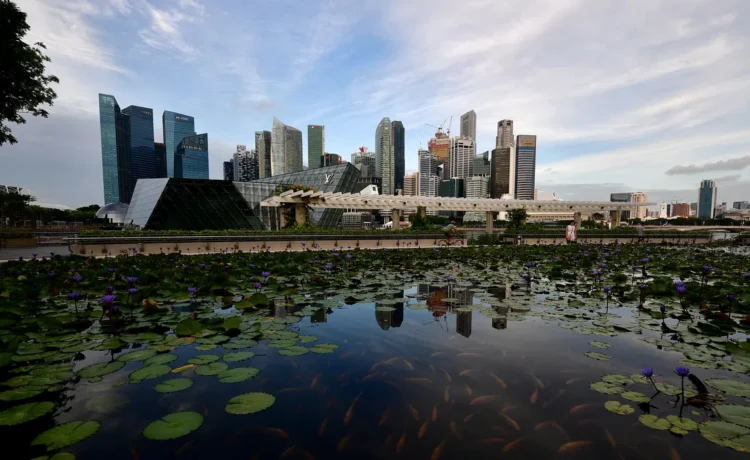SINGAPORE – Singapore’s economy could more than double by 2040, with the Singapore dollar potentially trading 1-for-1 against the US dollar and the Straits Times Index (STI) climbing to 10,000 points over the 15-year period, the Republic’s largest bank said in an Oct 22 report.
The DBS Singapore 2040 report, which outlines the bank’s projections for the economy, forecast that Singapore’s gross domestic product (GDP) could reach between US$1.2 trillion (S$1.56 trillion) and US$1.4 trillion by 2040 from US$547 billion in 2024, driven by capital accumulation, human capital development and productivity gains.
It added that the Republic’s growth has been underpinned by institutional strength and rising educational quality, which have helped sustain the country’s competitiveness over the past few decades.
Singapore rebounded strongly from the Covid-19 pandemic and now ranks as the eighth-largest economy in the Asia-Pacific and the second-largest in South-east Asia, while its nominal GDP more than doubled to US$547 billion in 2024, up from US$240 billion in the aftermath of the Global Financial Crisis in 2010.
“We forecast Singapore’s real GDP to grow at an average of 2.3 per cent annually between 2025 and 2040. Our projected economic expansion is expected to outstrip that of other advanced economies, and remains respectable for a mature country that has already reached the high-income frontier,” said DBS.
The report also noted that the US dollar may enter a multi-year correction as policymakers appear more open to a weaker currency, which creates room for the Singapore dollar to appreciate.
Further gains would be supported by productivity growth in Singapore driven by infrastructure, talent development, digital adoption and the green transition, with the Republic’s labour productivity outpacing the US over the past decade and likely to remain resilient.
DBS added that Singapore’s wealth has historically risen alongside its real exchange rate, and its role as a key supplier of high-value manufactured, refined and services exports has remained intact.
The Republic also consistently runs a sizeable current account surplus – meaning it earns more from trade and overseas investment income than it spends – and the International Monetary Fund expects this surplus to stay robust, easing only marginally in the coming years.
These conditions provide a strong basis for continued currency appreciation, said DBS.
The bank also noted that safe-haven inflows into Singapore’s real economy and financial sector will keep exerting appreciation pressure on the Singdollar.
“These flows will likely grow further in the coming years as Singapore doubles down on its efforts to attract investments in digital and physical infrastructure, tech-led manufacturing, and the green transition, while also deepening its capital markets,” it said.
On Singapore’s equities market, DBS said the STI’s strong year-to-date performance has been supported by various factors including fading US exceptionalism, a strong Singdollar, low domestic interest rates and recent initiatives by the Monetary Authority of Singapore (MAS) to revitalise the market.
The STI has gained more than 15 per cent since the start of 2025 and currently trades at well above 4,000 points, which it crossed for the first time in July.
Looking ahead, DBS said that passive inflows are likely to continue favouring large-cap counters listed on the Singapore Exchange, as overseas investors seek stable markets and safe-haven exposure.
Interest in small and mid-cap stocks is also expected to grow with support from the Government’s Equity Market Development Programme.
Stocks in the income and staples categories across all market capitalisations could benefit as well, as lower interest rates encourage investors to shift money out of deposits and money-market instruments and back into equities.
“The STI has broken a 17-year stalemate, surpassing 4,000 in 2025 and signalling a medium-term bullish shift… If historical return patterns hold, the STI could rise to nearly 10,000 by 2040,” said DBS.
Still, the bank noted that a “culture of risk-taking” will be needed for the next phase of growth.
“Singapore faces a critical juncture in attracting high-growth technology companies to list locally rather than on international exchanges,” it said.
Speaking at the launch of the report at Shangri-La Hotel on Oct 22, MAS deputy chairman Chee Hong Tat said the MAS-led Equities Market Review Group will complete its review by end-2025.
“Trading activity in Singapore equities including in small and mid-cap stocks has picked up, with average daily turnover in the third quarter of 2025 increasing by 16 per cent to $1.53 billion, the strongest level since the third quarter of the 2021 financial year,” he said.
Mr Chee, who is Minister for National Development, noted that in 2024, the financial services sector made up about 14 per cent of Singapore’s GDP and expanded by 6.8 per cent year on year – more than twice the pace recorded the year before.
The growth has been broad-based, spanning banking, insurance, capital markets, and asset and wealth management, he said.
Mr Chee also said the Government will announce more details of its “Value Unlock” programme in November.
which was announced in September
, is aimed at helping companies build capabilities, improve investor communications and foster collaborative networks.




